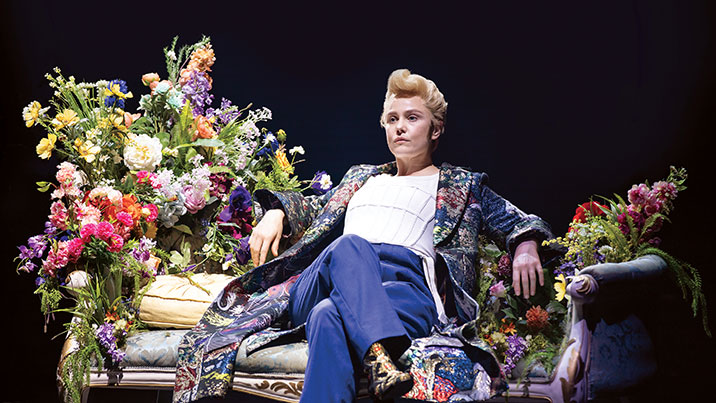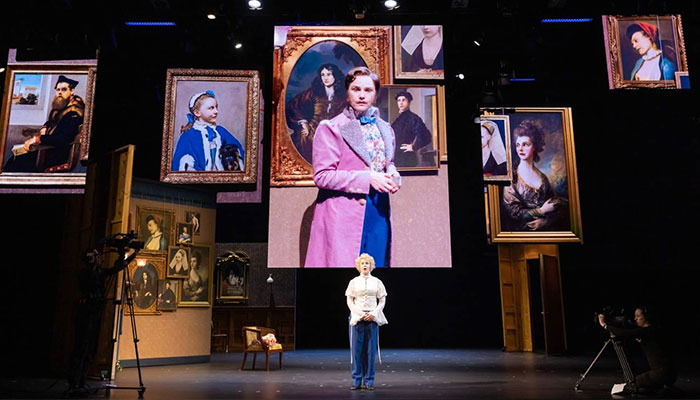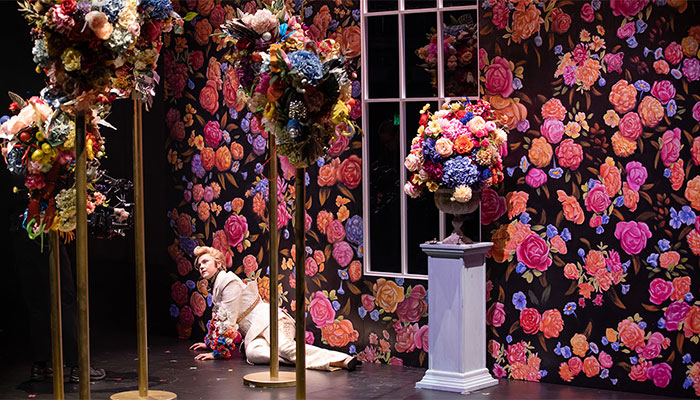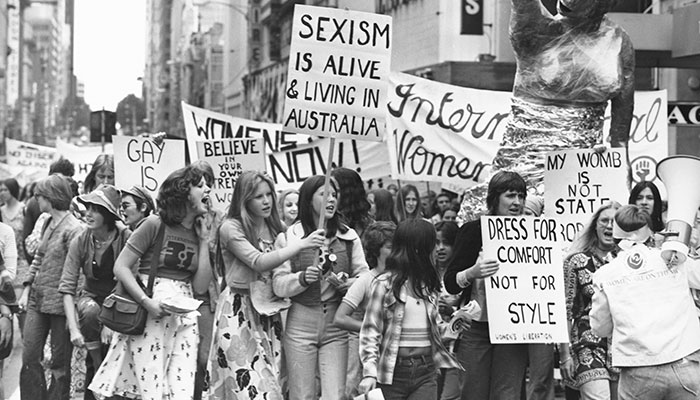For the hedonistic protagonist of Oscar Wilde’s The Picture of Dorian Gray (1890), “Life itself was the first, the greatest of the arts". Haunted by the fleeting youthful perfection captured in his portrait, Dorian embarks on an increasingly frenzied pursuit of pleasure, as though to fill his life with more beauty than the artwork.

Standing ovation: Eryn Jean Norvill in The Picture of Dorian Gray. Picture: Sydney Theatre Comany/Daniel Boud
In a fantastical twist known even to those who haven’t read Wilde’s book, Dorian’s beauty remains eerily intact across decades while his portrait ages, registering his increasing corruption in its malignant gaze.
Kip Williams’ gripping and intelligent adaptation of the novel meditates on the idea that life is the greatest of arts, examining questions that haunt Wilde’s story: What does it mean to aestheticise experience, to turn oneself into an artwork?
If this involves a thrilling devotion to beauty and pleasure, does it also alienate one from authentic emotion and corrupt one’s soul –as shown in Dorian’s increasingly hideous portrait, the literal embodiment of self-become-art? What is the relationship between representation and reality?
The brilliant Eryn Jean Norvill plays every role, shifting effortlessly between characters as she alters her inflection, cocks an eyebrow, or gestures with a cigarette.
In focusing on these questions, the Sydney Theatre Company’s Dorian Gray aims its adaptation of Wilde’s novel determinedly at contemporary audiences. Although its dialogue revels in Wilde’s famous witticisms, such as “it is only shallow people who do not judge by appearances”, it fixes firmly on themes that it adapts to speak to our own moment.
Dorian’s terror of ageing, inflamed by the decadent Lord Henry Wotton’s statement that “youth is the only thing worth having”, clearly evokes today’s obsession with youthful looks, which fuels whole industries ranging from cosmetic surgery to the beauty filters of Instagram.
Dorian’s aestheticisation of his life similarly points to the ways in which social media encourage us to present our experiences and identities as amplified spectacles of glamour and success. The play’s clever use of smartphone and screen technology creates an experience where the unreality of personal image is produced before the audience’s eyes.

Back in the picture: Dorian Gray's return to the stage this month, after a long pandemic delay, comes at a perfect moment. Picture: STC/Daniel Boud
The brilliant Eryn Jean Norvill plays every role in Dorian Gray, shifting effortlessly between characters as she alters her inflection, cocks an eyebrow, or gestures with a cigarette. Thanks to the talents of the STC crew and production team, as well as Williams’s adept direction, her virtuoso turn receives a technological boost: sometimes she interacts with pre-recorded videos of herself, and sometimes her live performance is projected onto huge screens that hang over the stage.
Capturing a contemporary moment
As an audience member, one is often tempted to watch these screens instead of looking directly at Norvill. In other words, one is drawn not to the event itself but to the representation, or what Wilde, in another of his famous paradoxes, called “the object as in itself it really is not".
Indeed, at several points Norvill is surrounded by circling camera operators who effectively hide her from view. The only way to see her is via the multiple mediations of these cameras and screens, underscoring Dorian’s belief that every human being is a “complex multiform creature” without a stable or permanent identity. In the absence of a single “real” self, perhaps representation is the only meaningful reality.
Yet this show also grapples with the ways in which self-aestheticising can become hollow, false and destructive. In one humorous but unsettling scene, Norvill-as-Dorian uses a smartphone to project an increasingly filtered version of her face onto the large screens, turning her skin unnaturally smooth and her eyes cartoonishly bright. As she toggles back and forth between this image and an unfiltered one, she transforms her own lovely face into the repulsive portrait meant to represent Dorian’s spiritual degradation.

Descent into hedonism: The STC’s production is centrally concerned with Dorian’s psychological and moral decline. Picture: STC/Daniel Boud
The production openly encourages us to recognise the intriguing parallels between fin-de-siècle love of artifice and 21st century obsession with image curation. Its return to the stage this month (after a long pandemic delay) comes at a perfect moment, when many of us are watching with fascinated horror the true-crime TV shows Inventing Anna and The Tinder Swindler, both of which feature people whose fraudulent curated personas supported hedonistic lifestyles while wreaking destruction on those around them.
Meanwhile the preoccupation with online influencers, and indeed with the meaning of ‘influence’, which is reflected in the docudrama Byron Baes, echoes another theme of the STC’s Dorian Gray: the “terribly enthralling” experience of exercising influence, as epitomized in Lord Henry’s pronouncement “to convey one’s temperament into another as though it were a subtle fluid or a strange perfume […] there’s a real joy in that”.
Standing ovation
Dorian’s descent into hedonism is a direct result of Lord Henry’s influence, and Dorian in turn leads others to succumb to his aesthetic allure. Though the concept of influence has changed between Wilde’s time and our own, the STC’s production prompts us to contemplate the abiding and compelling power of artifice.
Fin-de-siècle London is but the backdrop to the protagonist’s chaotic deterioration, writ large across multiple overlapping screens.
Gender issues also receive a contemporary treatment here. True, the male homoeroticism that surrounded The Picture of Dorian Gray with a crackle of scandal in the 1890s does not always translate in this astonishing one-woman show; here, decadence and aestheticism are symptomatic of society at large rather than a subculture.
But when Norvill dons a long blonde wig and a simpering smile to depict an actress taking on the role of Juliet, or when she presents Dorian in sideburns and a corset, this adaptation raises provocative questions about how self-performativity might relate to masculine and feminine stereotypes.
- How to stop doom scrolling and beat your bad news fatigue
- Early detection helps cancer patients beat the threat of lymphoedema
The STC’s production is centrally concerned with Dorian’s psychological and moral decline. The densely descriptive language of Wilde’s novel is preserved in the voiceover of the narrator (also played by Norvill), but the stage itself is minimal: a richly furnished room is evoked by a single divan or an oversized flower arrangement. Fin-de-siècle London is but the backdrop to the protagonist’s chaotic deterioration, writ large across multiple overlapping screens.
Some later elements of Wilde’s plot are changed, but the final tragedy, in which Dorian discovers he cannot outrun himself, is left the same.
It resonated powerfully with the audience, who rewarded Norvill and her technical cast of 12 with a standing ovation. A rewarding experience for fans of Wilde and his legacy, and for anyone interested in image, influence and the porous boundary between life and art.
Dr Veronica Alfano is a Research Fellow in Literature and Louise D’Arcens is Professor in the Department of Media, Communications, Creative Arts, Language and Literature.



